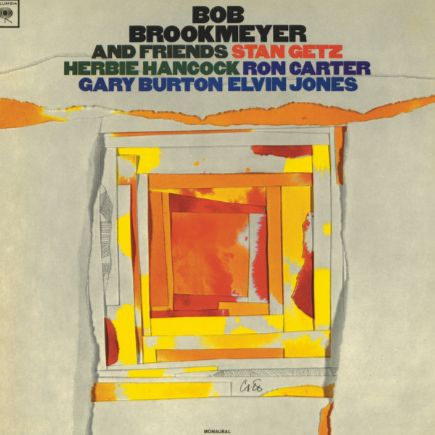Misty: naissance d’un standard entre brume et romantisme
À l’origine, Misty est une composition instrumentale écrite en 1954 par le pianiste américain Erroll Garner pour son album Contrasts, publié l’année suivante. Elle aurait été inspirée par un vol en avion au cours duquel Garner, contemplant le brouillard couvrant la ville en contrebas, aurait saisi cette image diffuse et poétique pour en faire la matrice d’un morceau à la fois intime et aérien.
En 1959, Misty prend une nouvelle dimension lorsque Johnny Burke en écrit les paroles. Le texte, empreint de rêverie et d’un amour presque irréel, épouse parfaitement l’atmosphère enveloppante de la musique.
C’est le chanteur Johnny Mathis qui fut le premier à enregistrer cette version chantée, d’abord sur son album Heavenly (août 1959), puis en single en septembre de la même année. Son interprétation rencontre un succès immédiat, ancrant Misty dans l’imaginaire collectif comme une chanson emblématique de la ballade romantique, à la croisée de la pop orchestrale et du jazz vocal.
En 1971, Clint Eastwood lui rend un hommage cinématographique dans son film Play Misty for Me (Un frisson dans la nuit), où le morceau devient le fil conducteur d’un thriller psychologique.
Bob Brookmeyer: lyrisme maîtrisé et modernité subtile
Enregistrée le 27 mai 1964 à New York, cette version de Misty figure sur l’album Bob Brookmeyer And Friends, fruit d’une rencontre exceptionnelle entre le tromboniste Bob Brookmeyer, le saxophoniste ténor Stan Getz et une jeune section rythmique de haut vol réunissant Gary Burton (vibraphone), Herbie Hancock (piano), Ron Carter (basse) et Elvin Jones (batterie). Initialement restée dans l’ombre, cette séance a été rééditée par Columbia en 1980, révélant une richesse musicale largement sous-estimée.
Bob Brookmeyer et Stan Getz, qui avaient déjà partagé la scène une décennie plus tôt, se retrouvent ici autour de cinq standards et de trois compositions originales de Brookmeyer. Si l’album pouvait apparaître comme un projet bop élégant mais relativement classique, la présence de musiciens aussi novateurs que Hancock, Carter ou Jones insuffle une tension moderne et un raffinement rythmique qui élèvent l’ensemble.
Brookmeyer, déjà reconnu pour son travail avec Gerry Mulligan et son rôle d’arrangeur pour le Thad Jones/Mel Lewis Orchestra, démontre dans Misty toute l’étendue de son art: un trombone à pistons au timbre velouté, un phrasé libre et expressif et une sensibilité harmonique rare.
Misty: nacimiento de un estándar entre la niebla y el romanticismo
Misty fue originalmente una composición instrumental escrita en 1954 por el pianista estadounidense Erroll Garner para su álbum Contrasts, publicado al año siguiente. Se dice que Garner se inspiró en un vuelo durante el cual, al contemplar la niebla que cubría la ciudad desde las alturas, captó esa imagen difusa y poética como punto de partida para una música íntima y etérea a la vez.
En 1959, Misty adquirió una nueva dimensión cuando Johnny Burke escribió su letra. El texto, impregnado de ensueño y de un amor casi irreal, se adapta perfectamente a la atmósfera envolvente de la música.
El cantante Johnny Mathis fue el primero en grabar esta versión cantada, primero en su álbum Heavenly (agosto de 1959) y luego como sencillo en septiembre del mismo año. Su interpretación tuvo un éxito inmediato, consolidando Misty en el imaginario colectivo como una canción emblemática de la balada romántica, situada entre la música pop orquestal y el jazz vocal.
En 1971, Clint Eastwood le rindió un homenaje cinematográfico en su película Play Misty for Me (Escalofrío en la noche), donde el tema se convierte en hilo conductor de un thriller psicológico.
Bob Brookmeyer: lirismo controlado y modernidad sutil
Grabada el 27 de mayo de 1964 en Nueva York, esta versión de Misty forma parte del álbum Bob Brookmeyer And Friends, resultado de un encuentro excepcional entre el trombonista Bob Brookmeyer, el saxofonista tenor Stan Getz y una joven sección rítmica de primer nivel compuesta por Gary Burton (vibráfono), Herbie Hancock (piano), Ron Carter (contrabajo) y Elvin Jones (batería). Esta sesión, inicialmente poco difundida, fue reeditada por Columbia en 1980, revelando una riqueza musical largamente subestimada.
Bob Brookmeyer y Stan Getz, que ya habían compartido escenario una década antes, se reúnen aquí para interpretar cinco estándares y tres composiciones originales de Brookmeyer. Aunque el álbum podría parecer un proyecto bop elegante pero convencional, la presencia de músicos tan innovadores como Hancock, Carter o Jones aporta una tensión moderna y una sofisticación rítmica que elevan el conjunto.
Reconocido ya por su trabajo junto a Gerry Mulligan y como arreglista para la Thad Jones/Mel Lewis Orchestra, Brookmeyer despliega en Misty toda la amplitud de su arte: un trombón de pistones con timbre aterciopelado, un fraseo libre y expresivo, y una sensibilidad armónica poco común.
Lejos de una lectura académica, aborda la balada de Erroll Garner con una flexibilidad rítmica sutil, jugando con silencios, pausas y acentos inesperados. El resultado es una reinterpretación tan respetuosa como personal, en la que el romanticismo de la melodía original se entrelaza con una libertad expresiva plenamente contemporánea.
Misty: nascita di uno standard tra nebbia e romanticismo
Misty nasce come composizione strumentale nel 1954, firmata dal pianista americano Erroll Garner per l’album Contrasts, pubblicato l’anno seguente. Si racconta che l’ispirazione sia nata durante un volo in aereo, quando Garner, osservando la nebbia che avvolgeva la città sotto di lui, trasformò quell’immagine sfocata e poetica nella matrice di una musica intima e leggera.
Nel 1959, Misty acquisisce una nuova dimensione con l’aggiunta del testo scritto da Johnny Burke. Le parole, pervase da un amore quasi irreale e da un’atmosfera onirica, si fondono perfettamente con il carattere avvolgente della musica.
Il primo a incidere la versione cantata fu il cantante Johnny Mathis, nel suo album Heavenly (agosto 1959), seguito dal singolo pubblicato a settembre dello stesso anno. La sua interpretazione ottenne un successo immediato, consacrando Misty nell’immaginario collettivo come emblema della ballata romantica, a metà strada tra la pop orchestrale e il jazz vocale.
Nel 1971, Clint Eastwood le rese omaggio nel suo film Play Misty for Me (Brivido nella notte), dove il brano diventa il filo conduttore di un thriller psicologico.
Bob Brookmeyer: lirismo controllato e modernità sottile
Registrata il 27 maggio 1964 a New York, questa versione di Misty è inclusa nell’album Bob Brookmeyer And Friends, frutto di un incontro eccezionale tra il trombonista Bob Brookmeyer, il sassofonista tenore Stan Getz e una giovane sezione ritmica d’eccellenza composta da Gary Burton (vibrafono), Herbie Hancock (pianoforte), Ron Carter (contrabbasso) ed Elvin Jones (batteria). Rimasta inizialmente in ombra, la sessione è stata ristampata da Columbia nel 1980, rivelando una ricchezza musicale largamente sottovalutata.
Brookmeyer e Getz, che avevano già suonato insieme dieci anni prima, si ritrovano qui per interpretare cinque standard e tre brani originali firmati da Brookmeyer. Se l’album poteva sembrare un progetto bop elegante ma piuttosto convenzionale, la presenza di musicisti innovatori come Hancock, Carter e Jones conferisce una tensione moderna e una raffinatezza ritmica che ne elevano il profilo.
Già noto per la sua collaborazione con Gerry Mulligan e per il ruolo di arrangiatore nella Thad Jones/Mel Lewis Orchestra, Brookmeyer dimostra in Misty tutta la profondità del suo linguaggio musicale: un trombone a pistoni dal timbro vellutato, un fraseggio libero ed espressivo e una sensibilità armonica rara.
Lungi da un’esecuzione accademica, affronta la ballata di Erroll Garner con una delicatezza ritmica raffinata, giocando con sospensioni, pause e accenti inaspettati. Ne risulta una rilettura rispettosa ma unica, dove il romanticismo della melodia originale si fonde con una libertà espressiva pienamente contemporanea.
Misty: the making of a standard between fog and romance
Originally an instrumental piece, Misty was composed in 1954 by American pianist Erroll Garner for his album Contrasts, released the following year. It is said that Garner was inspired during a plane flight, watching the mist covering the city below. That hazy, poetic image became the starting point for a piece both intimate and airy in nature.
In 1959, Misty took on a new life when lyricist Johnny Burke added words. The lyrics, filled with dreamlike sentiment and an almost unreal love, perfectly match the enveloping mood of the music.
Singer Johnny Mathis was the first to record the vocal version, initially for his album Heavenly (August 1959), and later released as a single in September of that year. His performance met with immediate success, establishing Misty in the public imagination as a quintessential romantic ballad, at the crossroads of orchestral pop and vocal jazz.
In 1971, Clint Eastwood paid tribute to the song in his film Play Misty for Me, where the track becomes the emotional thread of a psychological thriller.
Bob Brookmeyer: refined lyricism and subtle modernity
Recorded on May 27, 1964, in New York, this version of Misty appears on the album Bob Brookmeyer And Friends, the result of an exceptional session featuring trombonist Bob Brookmeyer, tenor saxophonist Stan Getz, and a stellar young rhythm section: Gary Burton (vibraphone), Herbie Hancock (piano), Ron Carter (bass), and Elvin Jones (drums). Initially overlooked, the session was reissued by Columbia in 1980, revealing a musical richness long underestimated.
Brookmeyer and Getz, who had performed together a decade earlier, reunited here to interpret five standards and three original compositions by Brookmeyer. While the album might have seemed like a polished but conventional bop outing, the presence of forward-thinking musicians like Hancock, Carter, and Jones injects a modern tension and rhythmic finesse that elevates the entire work.
Already acclaimed for his collaborations with Gerry Mulligan and his arranging work for the Thad Jones/Mel Lewis Orchestra, Brookmeyer displays in Misty the full breadth of his artistry: a valve trombone with a velvety tone, expressive and free phrasing, and a rare harmonic sensitivity.
Far from a textbook rendition, he approaches Erroll Garner’s ballad with delicate rhythmic elasticity, playing with breath, pauses, and unexpected accents. The result is a reinterpretation that is both respectful and distinctive, where the original romanticism meets a tone of modern freedom.
The accompaniment, understated and open, highlights Brookmeyer’s melodic lines, giving him the space to unfold nuanced and subtly orchestrated variations. This version of Misty, both emotive and elegant, perfectly encapsulates Brookmeyer’s musical ethos: demanding, inventive, and unreservedly open.


